Numerous studies have shown that trees add value to homes and communities.
A study of 3,229 municipally owned trees in Wooster, Ohio, in the summer of 2010, for example, found that each tree provided $83 in benefits annually, said Susan Littlefield, a horticulturalist with the National Gardening Association. The study found that the economic benefits of storing carbon, removing air pollution and helping to reduce storm water runoff provided a whopping $270,153 yearly value to the city! The study was conducted by Ohio State University graduate student Alejandro Chiriboga.
Trees, though, can transform from an aesthetically pleasing addition to a treacherous liability in storms, especially if rain is accompanied by high winds. When Hurricane Sandy roared ashore in the mid-Atlantic region on Oct. 29 with maximum sustained winds of 80 mph, much of the damage that left more than 8 million people without power was the result of gusts that uprooted trees and blew them across power lines and onto homes.
There are two reasons trees in urban and suburban landscapes are falling in storms like these, said Doug Tallamy, professor and chair of the Department of Entomology and Wildlife Ecology at the University of Delaware.
“First, we abuse their root systems by compacting the soil and mowing underneath every tree,” Tallamy said. “Tree roots hate compacted soil caused by mowing grass. They want nice leaf mulch with thick humus beneath it.”
The exposed root system of trees that blew over in Hurricane Sandy exposed another problem, said Tallamy. “The roots were a fraction of the size they should have been,” he said. “The roots of a healthy large oak should go more than 100 yards from the center of the tree.”
But there’s even bigger mistake homeowners often make when planting trees, said Tallamy — and that mistake is the second reason so many trees fall in storms.
“Homeowners tend to plant specimen trees,” he said. While the definition of specimen may vary among gardeners, specimen in this case means a single tree that is meant to be a highlight of the landscape. Specimen trees stand out and draw the attention of neighbors and passersby for their shape, height or the shade they provide the home during summer.
Trees that can become large that might be planted as specimen trees include American and sugar maples, sycamores, elms and most oaks.
“The problem with specimen trees is that they are isolated and they can't interlock their roots with other tree roots,” Tallamy said. “Specimen trees are the ones that blow over in storms. When trees are planted close together from a young age, they interlock their roots and form a matrix underground which is impossible to blow over.”
Tallamy contends that a consequence of Hurricane Sandy and other wind storms is that we end up with even fewer trees in home landscapes not only because the storms bring them down but because the ones left standing send people into a panic.
“Storms like Sandy scare people into cutting down any tree near their house in case it might fall someday,” Tallamy explained.
The result is that there are fewer trees to sequester even less carbon and support even smaller food webs for birds and beneficial insects.
What’s a homeowner to do?
So how can homeowners create a landscape in which mature trees will be able to withstand windstorms and still give the home will curb appeal? Is there a formula for the types of trees and the ratio of space for trees to lawn area?
While Tallamy said he is not aware of any research into this question, he does have a suggestion for homeowners. “I envision tree groves, instead of tree specimens,” he said. “So the tree area would look pretty much like a section of natural forest.”
That doesn’t mean that homeowners should turn the front lawn into a stand of trees that will eventually hide the house. Tree groves can be planted to the side of the property with a lawn area in front of the house. The open space will sweep the eyes of neighbors and others up to the front of the house and create a pleasing view of the property from the street.
The area under the tree canopy, to the extent possible, should be mulched, which will enrich the soil, rather than planted with grass, which results in compacted soil that restricts the growth of tree roots.
The grass itself won’t compact the soil, Tallamy said. “It's the care of the grass with the constant mowing and trampling of the soil around the tree roots, particularly with large mowing machines, that causes the problem,” he said.
When considering what trees to plant in your landscape, Tallamy urges homeowners to plant native American trees rather than those from Asia or elsewhere. “The trees in our yards are now important instruments for conservation because they support the biodiversity that runs our ecosystems,” Tallamy said. “Research has shown that native trees accomplish this far better than non-natives.”
To determine which trees will grow the best in your area, consult a local nursery or call your agricultural extension service.
